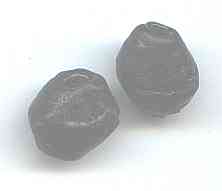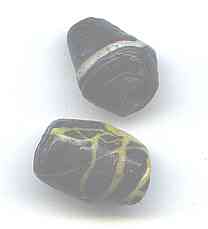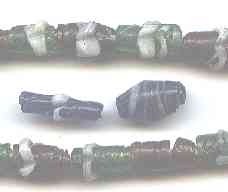The Bead SiteHome>Beadmaking & Materials>Glass Beads Made in Africa: Bida
Glass Beads Made in Africa
Part One, Bida, Nigeria
Many African countries make glass today for practical purposes. However, traditional glassmaking for beads is known only from Egypt and Nigeria. The first reference to the Nigerian industry of which I am aware was published in 1857 by Bowen (1968: 199).
It is not very detailed:
"They [the Nufes; modern Nupes] are said to be the only people in Sudan who still retain the art of manufacturing glass. At present this art is confined to three towns, one of which is west of the Niger, about two day's journey from Ilorrin." Bida is west of the Niger and some 200 km (120 miles) from Ilorin (now spelled with one 'r'), where Bowen was visiting.
|
Not until 1942 did Nadel (1951: 274-278) describe the process of glassmaking at Bida from first-hand observation. He noted that earlier writers had said that it had ceased, but that it was still done to make the dark brown or black glass locally known as bikini. The two beads above were made with this glass.
A special domed furnace was built and into a pit underneath was placed local sand, soda imported from Lake Chad, and after some time, blacksmith's slag. The whole needed to be heated constantly at a high temperature for three to five days, depending on the quantity of glass being made.
|
Hodge did give us the first description of beadmaking. The furnace is wider and the pit under it less shallow than the one used to make glass. Broken bottles and beads (for coloring) are allowed to melt in a pot.
One man withdraws a large gather of glass from the pot and drips it onto three iron mandrels each held by other men. Each man shapes the beads with a paddle and adds decoration of other glass with a pair of tongs. The beads were then knocked off and allowed to cool slowing in a pot adjacent to the furnace.
I still have many questions about this industry and am anxious to visit it first hand. Once things start settling down in Nigeria, Bida is on my list of bead-related places I intend to visit.
Part 1: Bida, Nigeria - Part 2: Kiffa and Wet-Core Beads
Part 3: Dry Powder-Glass Beads in Ghana
References:
Bowen, T. J.
1981 (orig. 1856) Adventures and Missionary Labours in Several Countries in the Interior of Africa from 1849 to 1856. Cass Library of African Studies, Missionary Researches and Travels, No. 3. London: Frank Cass & Co.
Frobenius, Leo
1913 The Voice of Africa, Volume 2. London: Hutchinson & Co. (2 vols.)
Gardi, René (Sigrid MacRae, trans.)
1969 African Crafts and Craftsmen. New York: Van Nostrand Reinhold.
Hodge, Alison
1981 Nigerian Traditional Crafts. Ethnographic Arts and Culture Series 3. London: Ethnographica.
London, Caryoln
1965 Safari for Gems, Part Three of 3 Parts: We "Discover" Kwalbite. Lapidary Journal.
Meek, C. K.
1971 (orig. 1925) The Northern Tribes of Nigeria, Volume 1 London: Frank Cass & Co. (2 vols.)
Nadel, S. F.
1951 (orig. 1942) A Black Byzantium: The Kingdom of Nupe in Nigeria. London: Oxford University Press.
__________________________________________________
Small Bead Businesses | Beading & Beadwork | Ancient Beads | Trade Beads
Beadmaking & Materials | Bead Uses | Researching Beads | Beads and People
Center for Bead Research | Book Store | Free Store | Bead Bazaar
Shopping Mall | The Bead Auction | Galleries | People | Events
The Bead Site Home | Chat Line | Contact Us | Site Search Engine | FAQ


